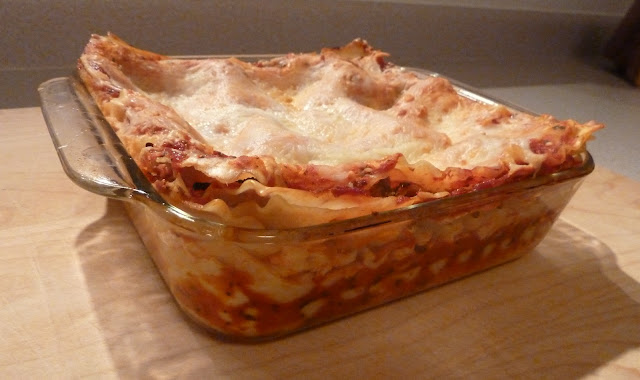Everyone loves lasagna, don't they? Yes, it's some work but it makes a lot and re-heats or freezes really well. It's great for a weekend afternoon project. I'd like to pass along three techniques that I've recently learned for making lasagna in addition to giving you a really good recipe in case you don't happened to have one from your great-grandmother.
1. Lasagna is too big
Not many of us have huge families any more and it seems a shame to reserve lasagna only for big parties. If you make it for a small family, you end up eating it every day for the next two weeks which is probably not the best idea. So what are you supposed to do with a 9x13 pan of lasagna? Make two smaller pans. I used the following recipe that called for a typical 9x13 pan and instead used two glass dishes that were each about 8" square. Have one for dinner and freeze the other one for later or give it to a friend or relative. Why did it take my entire life for me to figure this out?
 |
| baked and cooled - love the way the noodles rise at the corners |
For greater structural integrity, place each layer of noodles in the opposite direction. Again, why didn't I do this before? Maybe because the noodles were sized to fit a 9x13 pan. See #1 above.
3. Lasagna runs all over when you serve it
Take a tip from restaurants and bake the lasagna the day before you want to serve it. It cuts into perfect, clean pieces the next day prior to re-heating. This gives you the added benefit of being able to serve lasagna any night of the week.
One last thought - when The Lawyer and I were making the lasagna for this post (yes, he helps) he asked me why it didn't call for no-cook noodles. The reason is structural integrity - how the lasagna holds together when you cut and serve it. This recipe has good structural integrity due to three reasons - the ratio of sauce to noodles, the slight overlapping of the individual noodles, and criss-crossing the noodle layers. If you use no-cook noodles you have to use more sauce because the noodles absorb moisture as they cook. You shouldn't overlap them because they expand in all directions as they absorb moisture, and it's harder to criss-cross the layers because you can't neatly cut them to size. You could try breaking them but that sounds a lot harder. So, if you value the convenience of no-cook noodles and don't care that the lasagna layers might slide around a little on your plate, go ahead and use them.
* * click here for a printable recipe * *
Lasagna
Makes 1-9x13 pan or 2-8x8 pans
1-1/2 (16 oz) boxes of lasagna noodles
Olive oil
1 pound Italian sausage (hot or mild or a mix)
4 cloves garlic, smashed, divided
Crushed red pepper flakes
1 (12 oz) package cremini mushrooms, stems removed and caps sliced
1 large zucchini, cut in quarters lengthwise and sliced crosswise
2 cups ricotta
2 cups grated parmesan, divided
2 eggs, lightly beaten
6 to 7 fresh basil leaves, cut into chiffonade
1 large jar marinara sauce (or homemade)
1 pound grated mozzarella
Bring a large pot of salted water to a boil. Working in batches, cook the lasagna noodles until they’re soft and pliable but not limp, 6-7 minutes. Remove from the water and lay flat on parchment paper or a sheet tray to cool.
In a large sauté pan, place 1 tablespoon of olive oil over medium-high heat. Remove the sausage from casings, add to the pan and cook, breaking up with a wooden spoon, until brown and crumbly. Remove from the pan and reserve on paper towels.
Pour the fat from the pan and add new olive oil together with 2 cloves of garlic and a pinch of crushed red pepper over medium heat (be careful not to burn the garlic). When the garlic becomes very aromatic, remove it from the heat and discard. Add the mushrooms to the pan and season with salt. Cook until the moisture has evaporated and the mushrooms are golden, 4 to 5 minutes. Remove from the pan and reserve. Repeat the process with the remaining garlic and zucchini.
In a small bowl, combine the ricotta, half the parmesan, the eggs, and the basil. Mix to combine well and season with salt.
Preheat the oven to 350 degrees.
Spray a 9x13 deep baking dish (or two 8x8 baking dishes) with non-stick cooking spray. Spread the bottom of the dish with marinara sauce. Arrange a layer of lasagna noodles, overlapping slightly (cut to fit if needed). Spread 1/3 of the ricotta mixture over the noodles. Arrange a second layer of noodles over the ricotta in the other direction. Spread a light layer of sauce, then add 1/3 of the sausage, 1/3 of the mushrooms, and 1/3 of the zucchini. Sprinkle a layer of mozzarella and some of the remaining parmesan over the vegetables. Repeat these layers until all ingredients have been used up and the pan(s) are full. Be sure there is a layer of pasta on top covered with sauce and sprinkled with mozzarella and parmesan. Cover with foil.
Place the lasagna on a baking sheet and bake in the oven until hot and bubbly, about 75 minutes, removing the foil for the last 20 minutes or so. Let cool for 20 minutes before slicing.
May be baked in advance and reheated for the most perfect slices. May be frozen, baked or unbaked. Thaw overnight before baking or reheating.



1 comment:
tip number 2 saved my lasagna! why is no one talking about this
Post a Comment